According to a Drewry report, the development of mega LNG liquefaction projects continues to suffer in a coronavirus (COVID-19)-impacted market with low demand, historically low LNG prices and an oil price war on the sidelines.
Weaker Demand Growth
- The LNG market started 2020 with record low spot LNG prices due to weaker-than-expected demand growth in Asia and additions to liquefaction capacity weighing heavily on the market.
- Without doubt the COVID-19 outbreak in China has weakened the prospects for a recovery; as the country’s LNG demand has taken a big hit, with little chance of a significant improvement before 3Q20 at the earliest.
Meanwhile, the pandemic has spread to 60+ countries with more than 300,000 confirmed cases, which are rising at an alarming rate in countries such as Italy, Iran, the US, Japan, South Korea, Australia, Canada and India, with mass lockdowns impacting energy demand.
Higher Inventories
For 2020 we now expect LNG trade to grow by just 2% in 2020 due to low demand. A mild winter and a decline in Asian spot LNG prices have resulted in higher inventories in both Europe and Asia thereby impacting imports and we do not expect the scenario to change as the market enters the seasonal low-demand period.
Reduced LNG demand in Europe and Asia resulted in low LNG prices globally with the UK NBP price at $2.20 per MMBtu in March 2020, falling 29% from the start of the year while Asian spot LNG price declined to $3.40 per MMBtu in February from $5.90 per MMBtu in January.
LNG Production Hit
The virus outbreak is also taking a toll on LNG production as securing funding as well as supply deals is becoming increasingly difficult for planned liquefaction projects. This, in addition to the weaker economic scenario, has forced energy companies to re-assess their investments which will impact the development of many mega-LNG projects.
Threatened Profitability
Furthermore, as most of the long-term LNG contracts have oil-linked pricing, the collapse in oil price threatens the profitability of some of the major planned LNG projects. Oil prices tumbled in March 2020 after OPEC+ allies – Saudi Arabia and Russia – disagreed on further production cuts. Disagreement in the alliance has effectively allowed all countries to raise their production levels, flooding the market at a time when demand has collapsed under the COVID-19 strain.
Re-evaluating Strategies
After a bumper 2019 when 64 mtpa of liquefaction capacity reached the FID stage, many projects were in advanced stages of securing FID in 2020. However, depressed LNG prices and the impact of COVID-19 on LNG demand have led the developers to re-evaluate their strategies regarding the above projects which mean delays in reaching FID and commencement of operations. Major impacted projects include Rovuma LNG project (15.2 mtpa), Qatar’s North Field Expansion project (33 mtpa), Driftwood LNG (27.6 mtpa), Rio Grande LNG (27 mtpa) and Lake Charles (16.5 mtpa).
Scrapping Projects
Continuation of current conditions might even lead to the scrapping of some of these planned projects. Many of the planned projects targeted selling LNG at an average of $8 per MMBtu; however, current market conditions and a further collapse in oil prices do not justify the price tag any longer.
Most of these mega projects were scheduled to start in 2023-24 and possibly create a supply glut. However, the delay in the planned projects reaching FID as well as the delay in the under-construction projects will limit liquefaction capacity addition in the next five years. Meanwhile, many other proposed liquefaction projects will be scrapped or put on hold for a longer period.
Effect of Scrapping
The delay in these mega-LNG projects and limited liquefaction capacity addition are bound to have a ripple effect on the LNG shipping sector.
- For starters, lower capacity addition will eradicate the possibility of excessive supply and will support LNG prices.
- The additional vessels required to 2024 to transport LNG will reduce by about 40%, to 160 from 270 earlier. We also expect slippages to increase during the period coinciding with the delays in the under-development of projects.
- This would translate into lower orders for LNG vessels in the next three years.
- Project-based orders will decline and speculative orders are expected to dry up, squeezing fleet growth.
- Consequently, deliveries will slow down from 2022 and delays in liquefaction projects will also affect the development of LNG regasification infrastructure and other LNG-to-power projects which will suppress demand growth.
Low Fleet Growth
Going forward, we can expect slower fleet growth with low project-based or speculative orders. New liquefaction projects will find it hard to get off the drawing boards as investors will be looking for a diversified portfolio of supply and purchase contracts before committing to FID. The year 2020 is therefore expected to create a new “normal” for the LNG shipping business – from trade, shipping demand and charter rates – which will be much less attractive than previously expected.
Did you subscribe to our daily newsletter?
It’s Free! Click here to Subscribe!
Source: Drewry

























